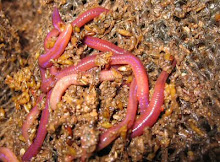Since it's been nearly eight months since my last post, I thought I'd give an update on the status of our bin. In September, we moved it out to the lanai of the building to avoid any unfortunate leachate leakage. At first, sun exposure was evaporating all the leachate--not necessarily a bad thing, as it makes for much easier maintenance if one doesn't have to drain out the moisture as often--but lately, I've had to drain quite a bit of liquid on a weekly basis, due to the generally cool and inclement weather of the past few months. Yesterday, I provided several containers worth to my fellow teacher, E., who has started up an Academy garden in conjunction with her "Nature" English elective. As of yet, the garden still lies fallow, as volunteers turned over the soil and mulched it just a few weeks ago; actual planting will not begin until May. The leachate will be used to supplement that garden as well as the kindergarten garden, so while we're still awaiting "black gold", our bin is still providing something useful to the larger school community.
The worms are thriving: I've watched several generations hatch from eggs, and when the protective layers of damp newspaper are moved in order to add food and circulate the organic matter, one sees a number of them squiggling into the subterranean depths, no doubt perturbed at the interruption of their slow, yet steady glutting. Unfortunately, the outdoor locale has also attracted less desirable life, namely outdoor cockroaches and ants, though I suppose I shouldn't be disparaging of the latter: after all, they too are decomposers and therefore, are serving a valuable function, even if they are loathsome...
I'm thinking about holding a (vermi)cast party and getting interested volunteers from the Hogwarts Community to help harvest the goods. Regardless of whether the party logistics come to fruition, however, I'm relishing the prospect of symbolically gifting the first vermicast so it fertilizes many gardens: those at the one at the Center for Public Service, the homes of faculty and staff, and our school.



